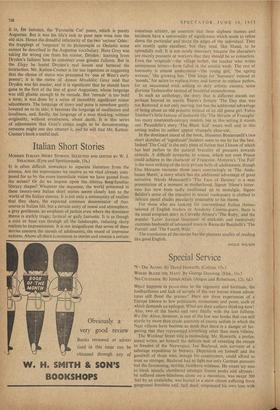Italian Short Stories
IT is often difficult nowadays to separate literature from the cinema. Are the impressions we ieceive as we read already com- posed for us by the more immediate vision we have gained from the screen? Or do we impose upon the cinema long-familiar literary shapes? Whatever the sequence, the world presented in these twenty-two Italian short stories seems closely knit to the world of the Italian cinema. It is not only a community of realism that they share, the expected common denominator of their source in Italian life, but a dertain unity of mood and atmosphere. a grey gentleness, an emphasis of pathos even where the dominant theme is starkly tragic, farcical or gaily fantastic'. It is as though a mist or haze ran through all the landscapes, reducing sharp realism to impressionism. It is not insignificant that seven of these stories concern the moods of adolescents, the mood of imprecise sadness. Above all there is common to stories and cinema a certain conscious artistry, an assertion that their slightest themes and incidents have a universality of significance which tends to refine down the particular and muzz the edges of the individual. They are mostly quite excellent, but they tend, like Maud, to be splendidly null. It is not surely necessary because the characters are mainly peasants or workers that they should be so colourless. Even the 'originals'—the village lecher, the teacher who writes anonymous letters—have faded in the artistic wash. The rest of humanity is almost anonymous—'the young girl,' the ageing woman,' the growing boy.' One longs for 'humours' instead of 'moods,' for satire to replace irony and horror to replace pathos, for an occasional trick ending to defy artistic canons, some glorious Technicolor instead of beautiful monochrome.
In such an anthology, the story that is different stands out perhaps beyond its merits. Papini's fantasy 'The Day that was not Restored' is not only moving, but has the additional advantage of being about an old princess instead of an old goose girl. Fabio Tombari's little fantasy of monastic life 'The Miracle of Frusaglia' has many nineteenth-century models, but in this setting it stands out. Pirandello's story 'The Black Kid' wears well and in this setting makes its author appear strangely clear-cut.
In the dominant mood of the book, Massimo Bontempelli's two short sketches of 'significant' incident seem to me by far the best. Indeed 'The Cock' is the only piece of fiction that I know of which has lent pathos to the natural brutality of peasants towards animals. A difficult sympathy to arouse, which not even Proust could achieve in the character of Francoise. Moravia's 'The Fall' is the most striking-of the little private hells of adolescence, though Elsa Morante recreates those years convincingly in 'The Anda- lusian Shawl,' a story which has the additional advantage of good narrative. Nicola Moscadelli's `The Face of Destiny' is a neat presentation of a moment in motherhood. Signor Silone's bitter- ness has now been sadly swallowed up in nostalgia; Signor Baldini's sense of the macabre in sexual inadequacy is clothed in delicate pastel shades peculiarly unsuitable to his theme.
For those who are looking for conventional Italian themes beloved of English readers or Academy Cinema-goers, there is the usual emigrant story in Corrado Alvaro's 'The Ruby,' and the popular 'Latin' farcical treatment of cuckolds and excessively uxorious husbands of advanced years in Riccardo Bacchelli's 'The Pursuit and 'The Fourth Wife.'
ANGUS WILSON










































 Previous page
Previous page